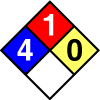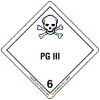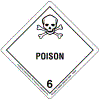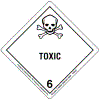Nitrogen Mustard HN-2: Blister Agent
CAS #:
51-75-2
RTECS #: IA1750000
UN #: 2810 (Guide 153)
Common Names:
- bis(2-Chloroethyl)methylamine
- MBA
- Mechlorethamine
Agent Characteristics
Pale amber to yellow oily liquid.
HN-2 is one of three nitrogen mustard blister agents (vesicants). Nitrogen mustards have not previously been used in warfare. The properties of nitrogen mustards are only slightly different from those of sulfur mustards, another major class of blister agents. However, exposure to nitrogen mustards may be more immediately toxic than exposure to sulfur mustard. Nitrogen mustards are alkylating agents that affect DNA and other molecules in the body. Exposure to nitrogen mustard damages the eyes, skin, and respiratory tract and suppresses the immune system. Although the nitrogen mustards cause cellular changes within minutes of contact, the onset of pain and other symptoms is delayed. Exposure to large amounts can be fatal. HN-2 has a fruity odor at high concentrations, and a soapy or fishy odor at low concentrations.
- Indoor Air: HN-2 can be released into indoor air as a liquid spray (aerosol) or as a vapor.
- Water: HN-2 can contaminate water.
- Food: HN-2 can contaminate food.
- Outdoor Air: HN-2 can be released into outdoor air as a liquid spray (aerosol) or as a vapor.
- Agricultural: If HN-2 is released into the air as a liquid spray (aerosol), it has the potential to contaminate agricultural products. If HN-2 is released as a vapor, it is highly unlikely to contaminate agricultural products.
HN-2 can be absorbed into the body by inhalation, ingestion, eye contact, and skin contact. Inhalation is an important route of exposure. Ingestion is an uncommon route of exposure. Tender skin, the moist lining of body passages and cavities (mucous membranes) and perspiration-covered skin are more sensitive to the effects of this agent.
Personal Protective Equipment
First Responders should use a NIOSH-certified Chemical, Biological, Radiological, Nuclear (CBRN) Self Contained Breathing Apparatus (SCBA) with a Level A protective suit when entering an area with an unknown contaminant or when entering an area where the concentration of the contaminant is unknown. Level A protection should be used until monitoring results confirm the contaminant and the concentration of the contaminant.
NOTE:Safe use of protective clothing and equipment requires specific skills developed through training and experience.
Select when the greatest level of skin, respiratory, and eye protection is required. This is the maximum protection for workers in danger of exposure to unknown chemical hazards or levels above the IDLH or greater than the AEGL-2.
- A NIOSH-certified CBRN full-face-piece SCBA operated in a pressure-demand mode or a pressure-demand supplied air hose respirator with an auxiliary escape bottle.
- A Totally-Encapsulating Chemical Protective (TECP) suit that provides protection against CBRN agents.
- Chemical-resistant gloves (outer).
- Chemical-resistant gloves (inner).
- Chemical-resistant boots with a steel toe and shank.
- Coveralls, long underwear, and a hard hat worn under the TECP suit are optional items.
Select when the highest level of respiratory protection is necessary but a lesser level of skin protection is required. This is the minimum protection for workers in danger of exposure to unknown chemical hazards or levels above the IDLH or greater than AEGL-2. It differs from Level A in that it incorporates a non-encapsulating, splash-protective, chemical-resistant splash suit that provides Level A protection against liquids but is not airtight.
- A NIOSH-certified CBRN full-face-piece SCBA operated in a pressure-demand mode or a pressure-demand supplied air hose respirator with an auxiliary escape bottle.
- A hooded chemical-resistant suit that provides protection against CBRN agents.
- Chemical-resistant gloves (outer).
- Chemical-resistant gloves (inner).
- Chemical-resistant boots with a steel toe and shank.
- Coveralls, long underwear, a hard hat worn under the chemical-resistant suit, and chemical-resistant disposable boot-covers worn over the chemical-resistant suit are optional items.
Select when the contaminant and concentration of the contaminant are known and the respiratory protection criteria factors for using Air Purifying Respirators (APR) or Powered Air Purifying Respirators (PAPR) are met. This level is appropriate when decontaminating patient/victims.
- A NIOSH-certified CBRN tight-fitting APR with a canister-type gas mask or CBRN PAPR for air levels greater than AEGL-2.
- A NIOSH-certified CBRN PAPR with a loose-fitting face-piece, hood, or helmet and a filter or a combination organic vapor, acid gas, and particulate cartridge/filter combination or a continuous flow respirator for air levels greater than AEGL-1.
- A hooded chemical-resistant suit that provides protection against CBRN agents.
- Chemical-resistant gloves (outer).
- Chemical-resistant gloves (inner).
- Chemical-resistant boots with a steel toe and shank.
- Escape mask, face shield, coveralls, long underwear, a hard hat worn under the chemical-resistant suit, and chemical-resistant disposable boot-covers worn over the chemical-resistant suit are optional items.
Select when the contaminant and concentration of the contaminant are known and the concentration is below the appropriate occupational exposure limit or less than AEGL-1 for the stated duration times.
- Limited to coveralls or other work clothes, boots, and gloves.
Emergency Response
- HN-2 is not stable except as dry crystals.
- HN-2 decomposes before its boiling point is reached or condenses under all conditions; the reactions involved could generate enough heat to cause an explosion.
- Contact with metals may evolve flammable hydrogen gas.
- No immediate danger of fire or explosion.
- Polymerization of HN-2 results in components that present an explosion hazard in open air.
- When heated, vapors may form explosive mixtures with air, presenting an explosion hazard indoors, outdoors, and in sewers.
- Containers may explode when heated.
- HN-2 is combustible.
- The agent may burn but does not ignite readily.
- Fire may produce irritating, corrosive, and/or toxic gases.
- For small fires, use dry chemical, carbon dioxide, or water spray.
- For large fires, use dry chemical, carbon dioxide, alcohol-resistant foam, or water spray. Move containers from the fire area if it is possible to do so without risk to personnel. Dike fire control water for later disposal; do not scatter the material.
- Avoid methods that will cause splashing or spreading.
- For fire involving tanks or car/trailer loads, fight the fire from maximum distance or use unmanned hose holders or monitor nozzles. Do not get water inside containers. Cool containers with flooding quantities of water until well after the fire is out. Withdraw immediately in case of rising sound from venting safety devices or discoloration of tanks. Always stay away from tanks engulfed in fire.
- Runoff from fire control or dilution water may be corrosive and/or toxic, and it may cause pollution.
- If the situation allows, control and properly dispose of run-off (effluent).
- If a tank, rail car, or tank truck is involved in a fire, isolate it for 0.5 mi (800 m) in all directions; also, consider initial evacuation for 0.5 mi (800 m) in all directions.
- Small spills (involving the release of approximately 52.83 gallons (200 liters) or less), when HN-2 is used as a weapon
- First isolate in all directions: 100 ft (30 m).
- Then protect persons downwind during the day: 0.1 mi (0.2 km).
- Then protect persons downwind during the night: 0.1 mi (0.2 km).
- Large spills (involving quantities greater than 52.83 gallons (200 liters)), when HN-2 is used as a weapon
- First isolate in all directions: 200 ft (60 m).
- Then protect persons downwind during the day: 0.3 mi (0.5 km).
- Then protect persons downwind during the night: 0.7 mi (1.1 km).
- Vapors are heavier than air. They will spread along the ground and collect and stay in poorly-ventilated, low-lying, or confined areas (e.g., sewers, basements, tanks).
- Hazardous concentrations may develop quickly in enclosed, poorly-ventilated, or low-lying areas. Keep out of these areas. Stay upwind.
- Health: 4
- Flammability: 1
- Reactivity: 0
- Special:

- OSHA: Not established/determined
- NIOSH: Not established/determined
- AIR MATRIX
No references were identified for this sampling matrix for this agent. - OTHER
No references were identified for this sampling matrix for this agent. - SOIL MATRIX
Gresham Gl, Groenewold GS, Olson JE [2000]. Identification of the nitrogen-based blister agents bis(2-chloroethyl)methylamine (HN-2) and tris(2-chloroethyl)amine (HN-3) and their hydrolysis products on soil using ion-trap secondary-ion mass spectrometry. J Mass Spectrom 35(12):1460-1469. - SURFACES
No references were identified for this sampling matrix for this agent. - WATER
No references were identified for this sampling matrix for this agent.
Signs/Symptoms
Clinical effects do not appear until hours after nitrogen mustard exposure. Nitrogen mustards penetrate and bind quickly to cells of the body, but their health effects develop slowly. The full extent of cellular injury may not be known for days. The sooner after exposure that health effects occur, the more likely it is that the patient/victim was exposed to a high concentration of mustard. Similarly, the sooner that health effects occur, the more likely it is that they will progress and become severe. Eye exposure: The eyes are the organs that are most sensitive to mustard vapor; eye injury may occur within 1 to 2 hours after severe exposure, or 3 to 12 hours after a mild to moderate exposure. Inhalation exposure: Airway injury may occur within 2 to 6 hours after severe exposure and within 12 to 24 hours after mild exposure. Skin exposure: The symptom-free (latent) period is 6 to 12 hours in temperate conditions; hot, humid weather strikingly increases the action of nitrogen mustards. Some skin injury may appear as late as 48 hours after exposure.
Nitrogen mustards damage the tissues of the eyes, skin, and respiratory tract. The skin healing process following mustard exposure is very slow. In addition to being blister agents (vesicants), nitrogen mustards are alkylating agents: when absorbed into the body, they can injure the bone marrow, lymph nodes, and spleen, causing a drop in white blood cell counts and increasing the risk of developing infections. Internal bleeding (hemorrhage) and a deficiency of red blood cells (anemia) may also result from bone marrow injury. Nitrogen mustards also affect the central nervous system (CNS). Nitrogen mustard exposure may be fatal; the cause of death is usually respiratory failure.
- Mild (onset within 4 to 12 hours): Tear production (lacrimation), irritation, itching, burning, spasmodic blinking (blepharospasm), dryness or gritty feeling, and possible pinpoint pupils (miosis).
- Moderate (onset within 3 to 6 hours): Above plus increased redness, fluid accumulation (edema) in the eyelids, and moderate pain.
- Severe (usually from liquid agent; onset within 1 to 2 hours): Increased fluid accumulation (edema) in eyelids, painful sensitivity to light (photophobia), damage to the cornea (ulceration), blindness, and severe pain.
- Nausea, vomiting (emesis), pain, hemorrhagic diarrhea, and chemical burns of the gastrointestinal (GI) tract.
- Mild (onset within 2 to 24 hours): Runny nose (rhinorrhea), sneezing, nosebleed (epistaxis), hoarseness progressing to “toneless” voice, barking cough, loss of taste and smell, wheezing and difficulty breathing or shortness of breath (dyspnea) in smokers and asthmatics, and nasal and sinus pain (occurring later).
- Severe (onset within 2 to 6 hours): Same as above, plus acute inflammation of the upper and lower airways; tissue death (necrosis) of the airway lining (respiratory epithelium); possible obstruction of both upper and lower airways due to formation of a false membrane or fibrous deposit (pseudomembrane); airway blockage (occlusion) from inflamed and dead (necrotic) cells; and death, due to inflammatory lung disease (pneumonia).
- Exposures to higher concentrations of vapor result in health effects that occur sooner and are more severe.
- Damage to the airways (and to tissues immediately surrounding the airways) begins with the upper airways and descends to the lower airways. The severity of damage increases as the concentration of nitrogen mustard increases.
- Tender skin, the moist lining of body passages and cavities (mucous membranes), and perspiration-covered skin are more sensitive to the effects of nitrogen mustard.
- Skin effects of liquid mustard occur sooner than do the effects of mustard vapor.
- Mild to moderate: Erythema (redness) begins to appear 1 to 24 hours after exposure (typically within 4 to 8 hours); blistering (vesication) begins 2 to 18 hours after onset of redness; possible intense itching (pruritus) and burning pain.
- Severe: As above, with more severe blistering (vesication) and areas of central tissue death (necrosis), plus whole-body (systemic) health effects including weakness (malaise), vomiting (emesis), fever, and complete exhaustion (prostration).
- Skin exposure to nitrogen mustard can be fatal. An area of redness (erythema), with or without blistering (vesication), which covers 25% or more of the body’s surface area, suggests a lethal exposure.
Decontamination
The purpose of decontamination is to make an individual and/or their equipment safe by physically removing toxic substances quickly and effectively. Care should be taken during decontamination, because absorbed agent can be released from clothing and skin as a gas. Your Incident Commander will provide you with decontaminants specific for the agent released or the agent believed to have been released.
The following are recommendations to protect the first responders from the release area:
- Position the decontamination corridor upwind and uphill of the hot zone.
- The warm zone should include two decontamination corridors. One decontamination corridor is used to enter the warm zone and the other for exiting the warm zone into the cold zone. The decontamination zone for exiting should be upwind and uphill from the zone used to enter.
- Decontamination area workers should wear appropriate PPE. See the PPE section of this card for detailed information.
- A solution of detergent and water (which should have a pH value of at least 8 but should not exceed a pH value of 10.5) should be available for use in decontamination procedures. Soft brushes should be available to remove contamination from the PPE.
- Labeled, durable 6-mil polyethylene bags should be available for disposal of contaminated PPE.
The following methods can be used to decontaminate an individual:
- Decontamination of First Responder:
- Begin washing PPE of the first responder using soap and water solution and a soft brush. Always move in a downward motion (from head to toe). Make sure to get into all areas, especially folds in the clothing. Wash and rinse (using cold or warm water) until the contaminant is thoroughly removed.
- Remove PPE by rolling downward (from head to toe) and avoid pulling PPE off over the head. Remove the SCBA after other PPE has been removed.
- Place all PPE in labeled durable 6-mil polyethylene bags.
- Decontamination of Patient/Victim:
- Remove the patient/victim from the contaminated area and into the decontamination corridor.
- Remove all clothing (at least down to their undergarments) and place the clothing in a labeled durable 6-mil polyethylene bag.
- Thoroughly wash and rinse (using cold or warm water) the contaminated skin of the patient/victim using a soap and water solution. Be careful not to break the patient/victim’s skin during the decontamination process, and cover all open wounds.
- Cover the patient/victim to prevent shock and loss of body heat.
- Move the patient/victim to an area where emergency medical treatment can be provided.
First Aid
Nitrogen mustards are extremely toxic and may damage the eyes, skin, and respiratory tract and suppress the immune system. Although these agents cause cellular changes within minutes of contact, the onset of pain and other symptoms is delayed. Thus, patients/victims arriving immediately from the scene of nitrogen mustard exposure are not likely to have signs and symptoms. The sooner after exposure that symptoms occur, the more likely they are to progress and become severe.
There is no antidote for nitrogen mustard toxicity. Decontamination of all potentially exposed areas within minutes after exposure is the only effective means of decreasing tissue damage.
- Immediately remove the patient/victim from the source of exposure.
- Immediately wash eyes with large amounts of tepid water for at least 15 minutes.
- Eyes must be decontaminated within minutes after exposure to reduce tissue damage.
- Do not cover eyes with bandages.
- Seek medical attention immediately.
- Immediately remove the patient/victim from the source of exposure.
- Ensure that the patient/victim has an unobstructed airway.
- Do not induce vomiting (emesis).
- Administer nothing by mouth (NPO).
- Seek medical attention immediately.
- Immediately remove the patient/victim from the source of exposure.
- Evaluate respiratory function and pulse.
- Ensure that the patient/victim has an unobstructed airway.
- If shortness of breath occurs or breathing is difficult (dyspnea), administer oxygen.
- Assist ventilation as required. Always use a barrier or bag-valve-mask device.
- If breathing has ceased (apnea), provide artificial respiration.
- Seek medical attention immediately.
- Immediately remove the patient/victim from the source of exposure.
- See the decontamination section for patient/victim decontamination procedures.
- Skin must be decontaminated within minutes after exposure to limit injury.
- To reduce the potential for whole-body (systemic) toxicity, decontaminate the patient/victim as late as 2 or 3 hours after exposure. Note that decontamination at this time may increase the severity of the skin reaction.
- Seek medical attention immediately.
Long-Term Implications
Because health effects due to nitrogen mustard may not occur until several hours after exposure, patients/victims should be observed in a hospital setting for at least 24 hours. Gastric lavage is contraindicated following ingestion of this agent due to the risk of perforation of the esophagus or upper airway. Following significant whole-body (systemic) absorption of nitrogen mustard, injury to the bone marrow, lymph nodes, and spleen may cause a drop in white blood cell counts (beginning on days 3 to 5), which can result in an increased risk for developing (life-threatening) infections. Counts of red blood cells and platelets may also fall due to bone marrow damage.
Following eye exposure, visual loss may return within days to months depending on the severity of exposure; however, permanent visual loss is rare. Chronic eye infections are possible. After-effects (sequelae) of inhalation exposure may include loss of taste and smell; chronic respiratory illness, including asthmatic inflammation of the large airways (bronchitis), recurrent respiratory infections, and increased fibrous tissue in the lung (fibrosis); and cancer of the airways (following repeated exposures). Skin scarring and pigment changes may follow a severe skin lesion from nitrogen mustard exposure; cancer sometimes develops in scarred skin. Nitrogen mustard exposures may produce lasting central nervous system (CNS) effects; minor psychological problems can last for a year or more after exposure.
HN-2 is a suspected carcinogen, developmental toxin, and reproductive toxin. Chronic or repeated exposure to HN-2 may cause bone marrow suppression, lymph node damage, weakening of the immune system, kidney damage, and reproductive system damage. Chronic or repeated exposure to HN-2 may cause genotoxicity.
On-Site Fatalities
- Consult with the Incident Commander regarding the agent dispersed, dissemination method, level of PPE required, location, geographic complications (if any), and the approximate number of remains.
- Coordinate responsibilities and prepare to enter the scene as part of the evaluation team along with the FBI HazMat Technician, local law enforcement evidence technician, and other relevant personnel.
- Begin tracking remains using waterproof tags.
- Wear PPE until all remains are deemed free of contamination.
- Establish a preliminary (holding) morgue.
- Gather evidence, and place it in a clearly labeled impervious container. Hand any evidence over to the FBI.
- Remove and tag personal effects.
- Perform a thorough external evaluation and a preliminary identification check.
- See the Decontamination section for decontamination procedures.
- Decontaminate remains before they are removed from the incident site.
Occupational Exposure Limits
- NIOSH REL:
- Not established/determined
- OSHA PEL:
- Not established/determined
- ACGIH TLV:
- Not established/determined
- NIOSH IDLH: Not established/determined
- DOE TEEL:
- TEEL-0: 1.25 mg/m3
- TEEL-1: 4 mg/m3
- TEEL-2: 29 mg/m3
- TEEL-3: 29 mg/m3
- AIHA ERPG:
- ERPG-1: Not established/determined
- ERPG-2: Not established/determined
- ERPG-3: Not established/determined
Acute Exposure Guidelines
| 10 min | 30 min | 60 min | 4 hr | 8 hr | |
|---|---|---|---|---|---|
| AEGL 1 (discomfort, non-disabling) – mg/m3 |
NR | NR | NR | NR | NR |
| AEGL 2 (irreversible or other serious, long-lasting effects or impaired ability to escape) – mg/m3 |
0.13 mg/m3 | 0.044 mg/m3 | 0.022 mg/m3 | 0.0056 mg/m3 | 0.0028 mg/m3 |
| AEGL 3 (life-threatening effects or death) – mg/m3 |
2.2 mg/m3 | 0.74 mg/m3 | 0.37 mg/m3 | 0.093 mg/m3 | 0.047 mg/m3 |
NOTE THAT VALUES ARE IN mg/m3, NOT ppm.
NR = Not recommended due to insufficient data
IMPORTANT NOTE: Interim AEGLs are established following review and consideration by the National Advisory Committee for AEGLs (NAC/AEGL) of public comments on Proposed AEGLs. Interim AEGLs are available for use by organizations while awaiting NRC/NAS peer review and publication of Final AEGLs. Changes to Interim values and Technical Support Documents may occur prior to publication of Final AEGL values. In some cases, revised Interim values may be posted on this Web site, but the revised Interim Technical Support Document for the chemical may be subject to change. (Further information is available through AEGL Process).
Decontamination (Environment and Equipment)
The following methods can be used to decontaminate the environment/spillage disposal:
- Do not touch or walk through the spilled agent if at all possible. However, if you must, personnel should wear the appropriate PPE during environmental decontamination. See the PPE section of this card for detailed information.
- Keep combustibles (e.g., wood, paper, and oil) away from the spilled agent.
- Use water spray to reduce vapors or divert vapor cloud drift. Avoid allowing water runoff to contact the spilled agent.
- Do not direct water at the spill or the source of the leak.
- Stop the leak if it is possible to do so without risk to personnel, and turn leaking containers so that gas rather than liquid escapes.
- Prevent entry into waterways, sewers, basements, or confined areas.
- Isolate the area until gas has dispersed.
- Ventilate the area.
Agents can seep into the crevices of equipment making it dangerous to handle. The following methods can be used to decontaminate equipment:
- Not established/determined
Agent Properties
- Chemical Formula:
C5H11Cl2N - Aqueous solubility:
Soluble - Boiling Point:
167°F (75°C) - Density:
Liquid: 1.118 at 77°F (25°C)
Vapor: 5.4 (air = 1) - Flammability:
Combustible - Flashpoint:
No immediate danger of fire or explosion
- Ionization potential:
Not established/determined
- Log Kbenzene-water:
Not established/determined - Log Kow (estimated):
1.53 - Melting Point:
-76°F (-60°C) - Molecular Mass:
156.06
- Soluble In:
Organic solvents
- Specific Gravity:
Not established/determined - Vapor Pressure:
0.427 at 77°F (25°C) - Volatility:
1,150 mg/m3 at 50°F (10°C)
3,580 mg/m3 at 77°F (25°C)
5,100 mg/m3 at 86°F (30°C)
10,000 mg/m3 at 104°F (40°C)
Hazardous Materials Warning Labels/Placards
- Shipping Name:
Toxic liquids, organic, n.o.s. - Identification Number:
2810 (Guide 153) - Hazardous Class or Division:
6.1 - Subsidiary Hazardous Class or Division:
- Label:
Poison (Toxic)
PG III - Placard Image:
Trade Names and Other Synonyms
- Caryolysin
- Caryolysine
- Chloramine
- Chlorethazine
- Chlormethine
- 2-Chloro-N-(2-chloroethyl)-N-methylethanamine
- bis(beta-Chloroethyl)methylamine
- N,N-bis(2-Chloroethyl)methylamine
- di(Chloroethyl)methylamine
- N,N-di(Chloroethyl)methylamine
- di(2-Chloroethyl)methylamine
- Dichlor amine
- Dichloren
- beta,beta’-Dichlorodiethyl-N-methylamine
- 2,2′-Dichloro-n-methyldiethylamine
- Diethylamine, 2,2′-dichloro-n-methyl-
- Embichin
- ENT-25294
- Ethanamine, 2-chloro-n-(2-chloroethyl)-n-methyl-
- HN2
- N-Lost (German)
- Mechlorethamine
- Mechlorethanamine
- N-Methyl-2,2′-dichlorodiethylamine
- N-Methyl-bis-chloraethylamin (German)
- Methylbis(2-chloroethyl)amine
- N-Methylbis(2-chloroethyl)amine
- Methylbis(beta-chloroethyl)amine
- N-Methylbis(beta-chloroethyl)amine
- Methylbis(chloroethylamine)
- Methyldi(2-chloroethyl)amine
- Mustargen
- Mustine
- NSC 762
- Stickstofflost (ebewe)
- TL 146
In the event of a poison emergency, call the poison center immediately at 1-800-222-1222. If the person who is poisoned cannot wake up, has a hard time breathing, or has convulsions, call 911 emergency services.
For information on who to contact in an emergency, see the CDC website at emergency.cdc.gov or call the CDC public response hotline at (888) 246-2675 (English), (888) 246-2857 (Español), or (866) 874-2646 (TTY).
The user should verify compliance of the cards with the relevant STATE or TERRITORY legislation before use. NIOSH, CDC 2003.



